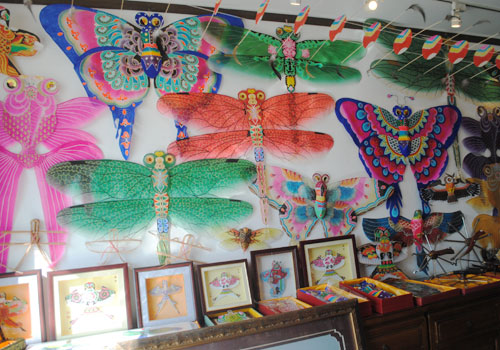Go fly a kite!
 |
|
The walls of Sanshizhai kites are coated with vibrantly-colored kites in a variety of shapes and sizes. [Photo:CRIENGLISH.com] |
March marks the beginning of kite-season in Beijing; brightly-colored kites are coming out of hibernation and taking flight in Beijing's parks as the weather warms and spring winds pick up speed.
Kites in Beijing have a long tradition. While many modern ones are made of synthetic materials and printed using computer-aided designs, as recently as 20 years ago, kites were all hand-made with silk or paper covering a bamboo frame.
One of the most popular kite-flying days is the Qingming Festival. "People related kites to their troubles. They would fly their kites on the festival, and when they went high into the sky, they would cut the thread. Then, the kites fly away with their troubles," Liu Bin, owner of Sanshizhai Kites explained.
Liu Bin's family has been making kites since imperial times. His great-grandfather was commissioned by the imperial palace to learn how to make high-quality kites for nobles, igniting the family business. His grandfather later found several kite shops. The family's traditions are alive and well in Liu Bin's Dianmen Avenue shop.
All kites in the shop are handmade, and his mother can be found sitting near the window, carefully attaching strings to kites-in-progress. Vibrantly-colored creations in the shapes of dragons, butterflies, birds, and fish coat the walls, making it difficult to pick just one favorite. The kite collection is supplemented by a selection of other traditional Chinese souvenirs for sale.
Swallows are traditionally the most popular kites in Beijing. "They're called the 'Beijing Swallows' because swallows don't fly south with the rest of the birds in winter," Liu Bin said. However, he noted that most foreigners who buy his kites choose dragonflies or butterflies instead because they aren't familiar with the symbolism associated with swallow-inspired kites.
In addition to different animals, there are different kinds of kites. There are over 10 different categories, and all of them have different characteristics. Three main kinds are sold in his shop -- hard wings, which are usually painted as swallows; soft wings, which are more flexible and have free-hanging fabric at the bottom and are most often designed as butterflies, dragonflies, or fish; and dragon kites, which are created as a long chain of body segments. One dragon kite on display spans from the front window to the back wall; Liu Bin mentioned that dragon kites in his grandfather's day could be up to 100 meters long.
Most of the kites in his shop are bought as gifts or souvenirs running from around 100-1,000 yuan; but he supplies competition kites, which run over 1,000 yuan and can take up to half a month to make, as opposed to half a day for a less complicated one. "Winning a kite competition has less to do with the skills of the kite flyer and more to do with the quality of the kite," Liu Bin explained. He says the best bamboo and silk materials must be selected and constructed meticulously into a kite. Competition winners should fly their kites so the string makes an 85-90 degree angle with the ground. Lower-quality kites can often fly high, but at a lower angle.
Curious visitors can schedule a kite-making class at 80 yuan per person; Liu Bin says his classes are most popular with families who bring children. Participants learn about the process, and then paint their own kites to take home to fly.
Whether a competitive flyer or a curious beginner, Beijing's windy spring weather is a great opportunity to engage in the pastime -- so pick up on the tradition and go fly a kite!
 0
0 






